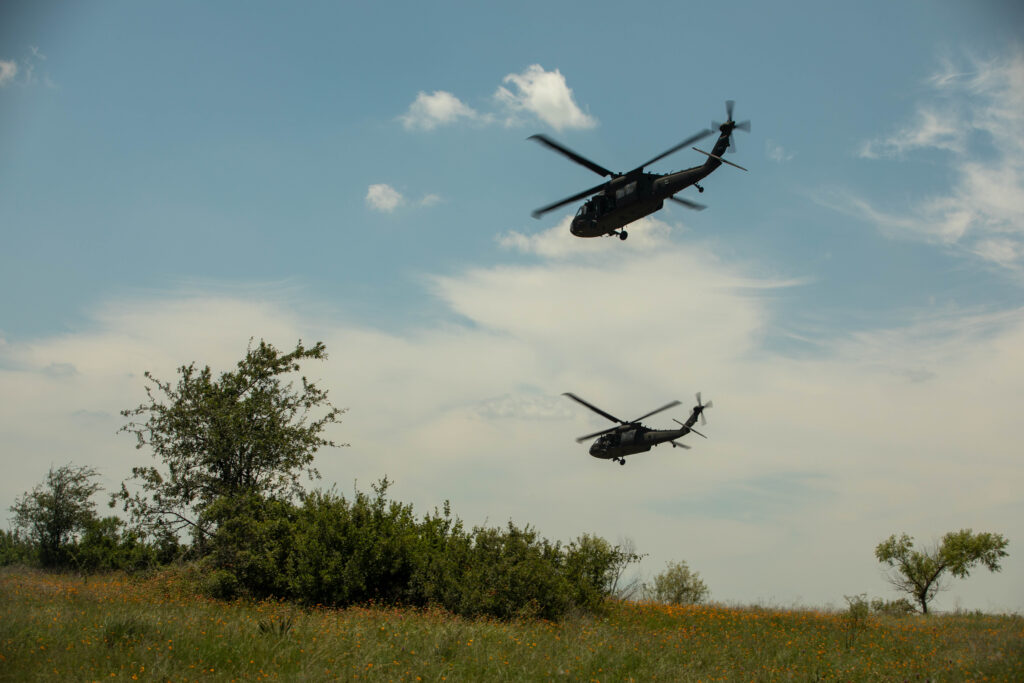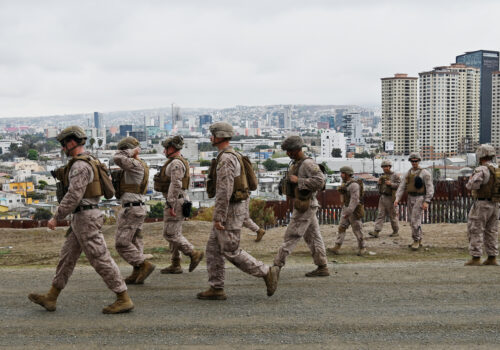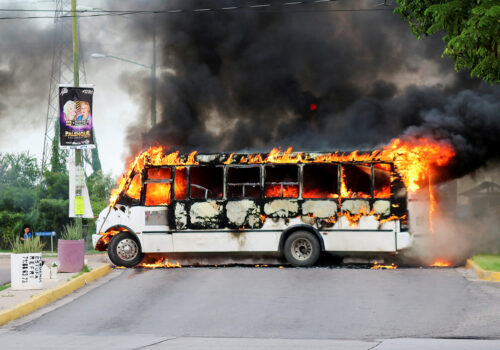During his address to Congress on March 4, US President Donald Trump did not mince words about the threat drug cartels pose: “The cartels are waging war on America, and it’s time for America to wage war on the cartels.” His statement marks the clearest indication so far that the new administration is serious about confronting the cartels and follows a series of escalating actions.
Two weeks earlier, on February 20, the Trump administration officially designated eight Latin American cartels, including six from Mexico, as Foreign Terrorist Organizations (FTOs) for their major roles in drug smuggling and human trafficking into the United States. The move marks a major escalation in the administration’s efforts to cripple the cartels, as an FTO designation grants the administration access to enhanced counterterrorism authorities, such as the ability to launch covert operations authorized by the president. The FTO designation came only days after the Mexican Senate approved the presence of the US Army’s 7th Special Forces Group to conduct joint training with Mexico’s elite Naval Marine Corps.
The Trump administration’s FTO designation and US Special Forces presence in Mexico comes as the administration is taking other notable steps. The United States has imposed new tariffs on Canada and Mexico to pressure them into greater cooperation against cartels and trafficking. On orders from the president, US Northern Command launched new deployments at the US southern border. And Central Intelligence Agency (CIA) surveillance drone flights, approved by Mexico, have reportedly gathered intelligence on cartel operations within the country. The rapid speed and scale of these apparent foreign counteroffensive preparations, arguably not seen since the early stages of the War on Terror, may indicate that the United States is on the verge of direct military action, either unilaterally or with the Mexican military, against cartels on Mexican soil.
While it remains unclear what the US administration will decide next, a scenario outlining what such an engagement might entail can be constructed by examining recent developments in the US-Mexico relationship and US counterterrorism efforts.
The following outlines a potential four-part sequence of events that could unfold if the United States conducts a direct military action against the cartels.
Step 1: Build relationships and training
US-Mexico cooperation is the best method of addressing the cartel problem. Therefore, at the start of this scenario, the new administration will likely work to establish operational partnerships with its Mexican counterparts. However, fostering reliable relationships may be challenging due to the country’s alleged entanglement with cartels.
Two recent criminal cases brought by the US Department of Justice against two of Mexico’s highest-ranking former law enforcement and military officials highlight the problem. In 2020, former Defense Minister Gen. Salvador Cienfuegos Zepeda was accused of using his position to aid the H-2 Cartel in drug smuggling. In 2024, former Mexican Secretary of Public Security Genaro García Luna was sentenced to thirty-eight years in prison for taking bribes from the Sinaloa Cartel in exchange for assisting the cartel. Moreover, a US Drug Enforcement Administration (DEA) report found evidence that cartels had funneled millions into the 2006 presidential campaign of Andrés Manuel López Obrador, known as AMLO.
In a move that perhaps anticipates the difficulty of engaging a government compromised by cartel influence, Trump appointed Ron Johnson as US ambassador to Mexico. Johnson is a former US ambassador to El Salvador, retired Green Beret, and veteran CIA officer with more than twenty years of experience leading sensitive paramilitary operations. He is uniquely equipped to secure cooperation from civilian officials while mitigating counterintelligence risks from cartel-affiliated public officials.
The US-Mexico military relationship presents a different set of challenges. During his term as president of Mexico (2018-2024), ALMO increased the funding and authority of the Secretariat of National Defense (SEDENA) in order to expand the main military branch’s role beyond military operations into civilian functions, such as law enforcement and infrastructure projects. However, this expansion occurred during a three-year absence (2019-2021) of a formal US-Mexico counternarcotics agreement, after AMLO pulled out of the Merida Initiative agreement in his first months in office. During this time, cartels extended their territorial control and fueled the rise of fentanyl-related overdose deaths in United States. The Mexican military’s expanding role in civil society and private business in recent years, coupled with allegations of corruption and cartel collusion, particularly around intelligence leaks, may complicate the US relationship with Mexico’s primary military branch. However, given its dominant role in Mexico’s national security, the US will continue to engage with SEDENA on conventional military cooperation, particularly in curbing migration and drug smuggling on the US-Mexico border.
By contrast, the smaller Secretariat of the Navy (SEMAR), a separate federal executive cabinet member, has built a strong record in conducting successful specialized counter-narcotics operations and has maintained a long-standing partnership with US forces and the DEA. Given its specialized capabilities and established US relationships, SEMAR is well-positioned to be a key partner in any potential US-led joint operations with Mexico against cartel leadership. The fact that the first joint training under the Trump administration was conducted by Green Berets and SEMAR further suggests this likelihood.
Step 2: Identifying first targets
What cartels might the United States target first? Among the candidates, the Sinaloa Cartel, one of two cartels reportedly responsible for the majority of drug trafficking into the United States, is likely high on the list. As the most powerful drug-trafficking organization in the Western Hemisphere, its influence extends beyond narcotics and human smuggling. The cartel has been involved in business extortion, illegal mining, and oil theft, as well as infiltrating formal businesses to launder money.
But what sets the Sinaloa Cartel apart is its deep ties to China in the fentanyl trade. The cartel has reportedly relied on Chinese suppliers for precursor chemicals, and it uses Chinese money-laundering networks to clean its illegal profits. The Sinaloa Cartel’s danger to US interests is so significant that it has been the primary target of congressional investigations and aggressive US law enforcement actions in recent years, with the most notable recent step against the group being the arrest of Ismael “El Mayo” Zambada, the co-founder and leader of the group, in 2024 by the Biden administration.
The Sinaloa Cartel’s willingness to partner with a major state adversary to flood the United States with deadly drugs underscores its growing brazenness in violating US sovereignty and undermining national security. Targeting the Sinaloa Cartel first would not only disrupt one of the largest fentanyl producers in the Western Hemisphere but also send a clear message to other cartels to refrain from engaging with China and other states hostile to the United States.
Step 3: Covert action and “shock and awe” strategy
Once training operations conclude and intelligence assets finalize target selection, the United States will need to consider its next steps. In the past, countercartel efforts have been managed primarily by US law enforcement agencies, such as the DEA and Federal Bureau of Investigation. These agencies conduct criminal investigations and collaborate with their Mexican counterparts to arrest cartel operatives for prosecution in Mexico or extradition to the United States for trial.
However, the new US administration’s decision to allocate significant resources from the Department of Defense and the CIA to dismantle the cartels suggests that more aggressive measures are also being considered, potentially including the launch of a military campaign. Such a step would require the administration to initiate a formal procedure for authorization.
The first option the Trump administration can pursue is a formal Authorization for Use of Military Force (AUMF) approved by Congress. This would allow the administration to deploy military assets in an open and continuous manner under Title 10 of the US Code. However, given the political sensitivity of US troops operating on Mexican soil, the administration may instead opt for a second option: a CIA-directed covert action conducted in secrecy and under Title 50. In this scenario, Trump would issue a presidential finding that authorizes the CIA to conduct covert actions against the cartels. From there, CIA paramilitary officers or special forces units, typically under Joint Special Operations Command (JSOC), would be used to carry out the secret operations. Trump has historically favored covert operations in counterterrorism efforts against al-Qaeda and the Islamic State of Iraq and al-Sham (ISIS), making this a more likely scenario.
Regardless of which option the administration chooses, it is likely to launch robust kinetic operations during the initial phase of the conflict. The Trump administration’s designation of the eight cartels as FTOs strongly supports this expectation. This is because the first Trump administration may have set a precedent when it placed Iran’s Islamic Revolutionary Guard Corps (IRGC) Quds Force on the FTO list just eight months prior to the assassination of its leader Qasem Soleimani. Importantly, the Department of Defense announcement of his killing references his leadership in the FTO-designated group in the opening sentence.
Specifically, in the cartel context, the United States may employ a “shock and awe” strategy that is similar to the first Trump administration’s rapid-strike military campaigns against ISIS. The goal of this approach would be to overwhelm the cartels’ forces through raids and to eliminate high-value cartel targets, particularly sicarios and mid-level commanders coordinating logistics and enforcement operations. In such a scenario, the United States would likely provide heavy air support in order to prevent cartel counteroffensives and ensure that targeted cells cannot regroup or retaliate. This may include US forces embedding with the Mexican navy’s special forces. Drone warfare may also be used to eliminate high-value cartel command centers, fentanyl production labs, and weapons depots.
Finally, it’s important to note that such direct actions against cartel factions will likely complement, not replace, ongoing bilateral operations between the United States and Mexico to extradite senior cartel leaders for prosecution. Instead, lethal actions can be expected to focus on cartel security forces and professional sicarios responsible for enforcing the cartel’s rule through violence in Mexico, including the assassination of elected officials, journalists, and innocent civilians.
Step 4: Concession and enforcement
Military force will be central in the early phases of the conflict, but the Trump administration has historically followed extreme pressure with engagement. Accordingly, after an initial shock-and-awe campaign, the administration is likely to push for the Mexican government to lead discussions with the cartels to compel them to end their drug smuggling, particularly synthetic drugs, and human trafficking operations in the United States, while also demanding that they sever business ties with state adversaries such as China.
Early signs of this strategy may already be emerging. In February, open-source intelligence indicated a ceasefire was brokered between the Grupo Escorpion and Metros cartels in the northern state of Tamaulipas that called for the end of fighting between the groups and an end to fentanyl trafficking into south Texas. This event, credited to pressure from the Mexican government, could serve as the recipe for future US efforts. This model of applying overwhelming force to compel cartels into submission, followed by behind-the-scenes discussions, will likely define the long-term course of the conflict. Continuous monitoring and enforcement will be essential to ensure compliance with the concessions.
After “shock and awe”
How would cartels respond to a “shock and awe” military campaign similar to that which destroyed the ISIS caliphate? While cartels control territory, command militia-style forces, and possess military-grade weaponry, they lack a standing army, which makes it more difficult for them to survive a sustained military campaign. Additionally, their tactics are limited to lightweight ambushes and terroristic actions, primarily targeting civilians and rival groups.
Unlike ideological terrorist organizations, cartels operate as businesses. When their funding streams and resources are severely threatened, they are more likely to adapt, negotiate, and shift operations rather than engage in prolonged conventional warfare. Therefore, targeted military attacks on cartels could potentially lead to successful cartel concessions. Furthermore, while direct narco-terrorist attacks on US soil from Mexican cartels are unlikely, US military actions against them could create an opportunity for other state-sponsored groups to conduct counteroffensive attacks, such as targeting US law enforcement officials and terrorizing civilians.
While it remains to be seen whether the United States will conduct direct military action, one thing is clear: the Trump administration’s efforts to combat drug smuggling and human trafficking into the United States is not likely to be a short-term political goal. Instead, these efforts represent a significant step in redefining US grand strategy away from maintaining the country’s post–World War II global primacy toward securing concrete national interests closer to home. Secretary of Defense Pete Hegseth articulated this shifting policy during a recent Pentagon town hall, stating, “Chaos happens when the perception of American strength is not complete. And so, we aim to reestablish that deterrence, and it starts with our own southern border. It starts with the defense of our homeland.”
James Fowler is a counterterrorism expert who specializes in leveraging technology to support democratic governance and institutional resilience. A retired Special Operations Command (SOCOM) operator, he brings extensive experience in counterterrorism operations and security strategy. Fowler is a member of the Atlantic Council’s Counterterrorism Project, where he contributes to policy discussions and strategic initiatives aimed at enhancing global security.
Alicia Nieves is a legal expert in immigration and refugee law, specializing in humanitarian assistance and conflict rescue. She is a member of the Atlantic Council’s Counterterrorism Project and co-founder of the Gaza Family Project, an initiative of the Arab-American Civil Rights League (ACRL) dedicated to helping American families impacted by the Israel-Hamas war.
Further reading
Mon, Mar 3, 2025
To tackle China-enabled drug cartels in Mexico, Trump will need military authorization
New Atlanticist By
An authorization to use military force against Mexican drug cartels would unite various government agencies in a coordinated effort to combat a major threat to US national security.
Thu, Jan 16, 2025
How Sheinbaum can strengthen US-Mexico ties in Trump’s first 100 days
New Atlanticist By
Decisions taken in the next few months about the US-Mexico relationship could shape the two nations’ bilateral ties for years to come.
Tue, Jan 14, 2025
US intervention against Mexican cartels carries major risks. Here’s how to mitigate them.
New Atlanticist By
Cartels have a significant capability to retaliate, but there are ways that the United States can prepare for such risks.
Image: US Army Arizona National Guard 285th Aviation Regiment conducts reconnaissance from a UH-60 Black Hawk at Fort Cavazos, Texas, June 9, 2024. The reconnaissance was part of an XCTC exercise with the Tennessee Army National Guard. (US Army National Guard photo by Sgt. Everett Babbitt)



